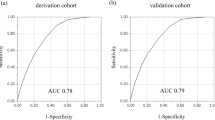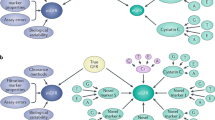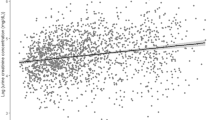Abstract
Chronic kidney disease is common in the general population and associated with excess cardiovascular disease (CVD), but kidney function does not feature in current CVD risk-prediction models. We tested three formulae for estimated glomerular filtration rate (eGFR) to determine which was the most clinically informative for predicting CVD and mortality. Using data from 440,526 participants from UK Biobank, eGFR was calculated using serum creatinine, cystatin C (eGFRcys) and creatinine-cystatin C. Associations of each eGFR with CVD outcome and mortality were compared using Cox models and adjusting for atherosclerotic risk factors (per relevant risk scores), and the predictive utility was determined by the C-statistic and categorical net reclassification index. We show that eGFRcys is most strongly associated with CVD and mortality, and, along with albuminuria, adds predictive discrimination to current CVD risk scores, whilst traditional creatinine-based measures are weakly associated with risk. Clinicians should consider measuring eGFRcys as part of cardiovascular risk assessment.
This is a preview of subscription content, access via your institution
Access options
Access Nature and 54 other Nature Portfolio journals
Get Nature+, our best-value online-access subscription
$29.99 / 30 days
cancel any time
Subscribe to this journal
Receive 12 print issues and online access
$209.00 per year
only $17.42 per issue
Buy this article
- Purchase on Springer Link
- Instant access to full article PDF
Prices may be subject to local taxes which are calculated during checkout



Similar content being viewed by others
Data availability
The UK Biobank data that support the findings of this study are available from the UK Biobank (www.ukbiobank.ac.uk). This study was conducted under project code 9310.
Change history
15 July 2020
An amendment to this paper has been published and can be accessed via a link at the top of the paper.
References
Hill, N. R. et al. Global prevalence of chronic kidney disease—a systematic review and meta-analysis. PLoS ONE 11, e0158765 (2016).
Evans, M. et al. Risk factors for prognosis in patients with severely decreased GFR. Kidney Int. Rep. 3, 625–637 (2018).
Go, A. S., Chertow, G. M., Fan, D., McCulloch, C. E. & Hsu, C. Chronic kidney disease and the risks of death, cardiovascular events, and hospitalization. N. Engl. J. Med. 351, 1296–1305 (2004).
Grams, M. E. et al. Predicting timing of clinical outcomes in patients with chronic kidney disease and severely decreased glomerular filtration rate. Kidney Int. 93, 1442–1451 (2018).
Chartier-Harlin, M.-C. et al. Alpha-synuclein locus duplication as a cause of familial Parkinson’s disease. Lancet 364, 1167–1169 (2004).
Neri, L. et al. Detecting high-risk chronic kidney disease-mineral bone disorder phenotypes among patients on dialysis: a historical cohort study. Nephrol. Dial. Transplant. 34, 682–691 (2019).
Levin, A. et al. Prevalence of abnormal serum vitamin D, PTH, calcium, and phosphorus in patients with chronic kidney disease: results of the study to evaluate early kidney disease. Kidney Int. 71, 31–38 (2007).
Sarnak, M. J. et al. Kidney disease as a risk factor for development of cardiovascular disease. Circulation 108, 2154–2169 (2003).
Israni, A. K. et al. Predicting coronary heart disease after kidney transplantation: patient outcomes in renal. Transplantation (PORT) Study. Am. J. Transplant. 10, 338–353 (2010).
Kasiske, B. L. et al. Cardiovascular disease after renal transplantation. J. Am. Soc. Nephrol. 7, 158–165 (1996).
Kidney Disease Working Group. Kidney disease: improving global outcomes. KDIGO 2012 clinical practice guideline for the evaluation and management of chronic kidney disease. Kidney Int. Suppl. 3, 1–150 (2013).
Gansevoort, R. T. et al. Chronic kidney disease and cardiovascular risk: epidemiology, mechanisms, and prevention. Lancet 382, 339–352 (2013).
Matsushita, K. et al. Estimated glomerular filtration rate and albuminuria for prediction of cardiovascular outcomes: a collaborative meta-analysis of individual participant data. Lancet Diabetes Endocrinol. 3, 514–525 (2015).
Matsushita, K. et al. Association of estimated glomerular filtration rate and albuminuria with all-cause and cardiovascular mortality in general population cohorts: a collaborative meta-analysis. Lancet 375, 2073–2081 (2010).
Nitsch, D. et al. Associations of estimated glomerular filtration rate and albuminuria with mortality and renal failure by sex: a meta-analysis. BMJ 346, 1–14 (2013).
Hippisley-Cox, J., Coupland, C. & Brindle, P. Development and validation of QRISK3 risk prediction algorithms to estimate future risk of cardiovascular disease: prospective cohort study. BMJ 357, j2099 (2017).
Piepoli, M. F. et al. 2016 European Guidelines on cardiovascular disease prevention in clinical practice. Eur. Heart J. 37, 2315–2381 (2016).
Goff, D. C. et al. 2013 ACC/AHA guideline on the assessment of cardiovascular risk: a report of the American College of Cardiology/American Heart Association task force on practice guidelines. Circulation 129, S49–S73 (2014).
Levey, A. A. S. et al. A new equation to estimate glomerular filtration rate. Ann. Intern. Med. 150, 604–612 (2009).
Inker, L. A. et al. Estimating glomerular filtration rate from serum creatinine and cystatin C. N. Engl. J. Med. 367, 20–29 (2012).
Shlipak, M. G. et al. Cystatin C versus creatinine in determining risk based on kidney function. N. Engl. J. Med. 369, 932–943 (2013).
Shlipak, M. G., Mattes, M. D. & Peralta, C. A. Update on cystatin C: incorporation into clinical practice. Am. J. Kidney Dis. 62, 595–603 (2013).
Costing Statement: Chronic Kidney Disease. Implementing the NICE Guideline on Chronic Kidney Disease (CG182) (NICE, 2014).
Chronic Kidney Disease in Adults: Assessment and Management (NICE, 2014).
Myers, G. L. et al. Recommendations for improving serum creatinine measurement: a report from the Laboratory Working Group of the National Kidney Disease Education Program. Clin. Chem. 52, 5–18 (2006).
Zi, M. & Xu, Y. Involvement of cystatin C in immunity and apoptosis. Immunol. Lett. 196, 80–90 (2018).
Salgado, J. V., Souza, F. L. & Salgado, B. J. How to understand the association between cystatin C levels and cardiovascular disease: imbalance, counterbalance, or consequence? J. Cardiol. 62, 331–335 (2013).
Van Diepen, M., Ramspek, C. L., Jager, K. J., Zoccali, C. & Dekker, F. W. Prediction versus aetiology: common pitfalls and how to avoid them. Nephrol. Dial. Transplant. 32, ii1–ii5 (2017).
Lamb, E. J. et al. The eGFR-C study: accuracy of glomerular filtration rate (GFR) estimation using creatinine and cystatin C and albuminuria for monitoring disease progression in patients with stage 3 chronic kidney disease—prospective longitudinal study in a multiethnic population. BMC Nephrol. 15, 13 (2014).
Tangri, N. et al. A predictive model for progression of chronic kidney disease to kidney failure. JAMA 305, 1553– (2011).
Herrington, W. G. et al. Impact of renal function on the effects of LDL cholesterol lowering with statin-based regimens: a meta-analysis of individual participant data from 28 randomised trials. Lancet Diabetes Endocrinol. 4, 829–839 (2016).
Baigent, C. et al. The effects of lowering LDL cholesterol with simvastatin plus ezetimibe in patients with chronic kidney disease (Study of Heart and Renal Protection): a randomised placebo-controlled trial. Lancet 377, 2181–2192 (2011).
KDIGO. Clinical Practice Guideline for Lipid Management in Chronic Kidney Disease. Kidney Int. 3, 182–189 (2013).
The SPRINT Research Group. A randomized trial of intensive versus standard blood-pressure control. N. Engl. J. Med. 373, 2103–2116 (2015).
Cheung, A. K. et al. Effects of intensive BP control in CKD. J. Am. Soc. Nephrol. 28, 2812–2823 (2017).
Welsh, C. et al. Comparison of conventional lipoprotein tests and apolipoproteins in the prediction of cardiovascular disease: data from UK Biobank. Circulation 140, 542–552 (2019).
Van Der Velde, M. et al. Lower estimated glomerular filtration rate and higher albuminuria are associated with all-cause and cardiovascular mortality. A collaborative meta-analysis of high-risk population cohorts. Kidney Int. 79, 1341–1352 (2011).
Chronic Kidney Disease Prevalence Model (Public Health England, 2014).
Witte, E. C. et al. First morning voids are more reliable than spot urine samples to assess microalbuminuria. J. Am. Soc. Nephrol. 20, 436–443 (2009).
Elliott, P. & Peakman, T. C. The UK Biobank sample handling and storage protocol for the collection, processing and archiving of human blood and urine. Int. J. Epidemiol. 37, 234–244 (2008).
Fry, A. et al. Comparison of sociodemographic and health-related characteristics of UK Biobank participants with those of the general population. Am. J. Epidemiol. 186, 1026–1034 (2017).
Byrne, C. et al. UK Renal Registry 19th Annual Report of the Renal Association. Nephron 137, 1–406 (2017).
Allen, N. et al. UK Biobank: current status and what it means for epidemiology. Health Policy Technol. 1, 123–126 (2012).
UK Biobank: Protocol for a Large-Scale Prospective Epidemiological Resource (UK Biobank Coordinating Centre, 2007).
Bush, K., Nolan, J., Zhang, Q., Herrington, W. & Sudlow, C. Definitions of End Stage Renal Disease for UK Biobank Phase 1 Outcomes Adjudication (UK Biobank Outcome Adjudication Group, UK Biobank, 2017).
UK Biobank Showcase: Blood Sample Collection, Processing and Transport (UK Biobank, 2011).
UK Biobank Showcase: Biospeciments Manual: Collection of Biological Samples, Processing and Storage (UK Biobank, 2011); https://biobank.ctsu.ox.ac.uk/crystal/docs/BioSampleProc.pdf
UK Biobank Showcase: Companion Document to Accompany Serum Biomarker Data v.1.0. (UK Biobank, 2011); https://biobank.ctsu.ox.ac.uk/showcase/docs/serum_biochemistry.pdf
UK Biobank’s Enhancements Working Group. UK Biobank biomarker panel. 1–4 (2014); http://www.ukbiobank.ac.uk/wp-content/uploads/2013/11/ukb_biomarker_panel_final_website_May14.pdf
UK Biobank Showcase: Details of Assays and Quality Control Information for the Urinary Biomarker Data v.1.0. (UK Biobank, 2016).
UK Biobank Showcase: Biomarker Assay Quality Procedures: Approaches Used to Minimise Systematic and Random Errors v.2.0. (UK Biobank, 2019); https://biobank.ctsu.ox.ac.uk/showcase/docs/biomarker_issues.pdf
Acknowledgements
We thank the participants of the UK Biobank. The work in this study was supported by a grant from Chest, Heart and Stroke Association Scotland (grant no. Res16/A165). J.S.L. has personal funding from a Kidney Research UK Training Fellowship Award (no. TF_013_20161125) and is supported by a British Heart Foundation Centre of Excellence Award (no. RE/13/5/30177).
Author information
Authors and Affiliations
Contributions
J.S.L. and P.B.M. conceived of and designed the study. Data were analyzed by C.E.W. and P.W. under UK Biobank project 9310 led by N.S. and involving all authors. The first draft of the manuscript was written by J.S.L. and C.E.W. All authors (J.S.L., C.E.W., P.W., P.B.M., N.S., C.A.C-M., D.M., S.R.G., J.G.C., J.M.R.G., P.S.J., J.L., D.M.L., J.P.) read, critically revised and approved the final manuscript.
Corresponding author
Ethics declarations
Competing interests
The authors declare no competing interests.
Additional information
Peer review information Jennifer Sargent was the primary editor on this article and managed its editorial process and peer review in collaboration with the rest of the editorial team.
Publisher’s note Springer Nature remains neutral with regard to jurisdictional claims in published maps and institutional affiliations.
Extended data
Extended Data Fig. 1 Unadjusted survival of effects of eGFRcr category on all-cause mortality.
Unadjusted survival of effects of eGFRcr category on all-cause mortality. Event-free survival decreases as eGFRcr declines.
Extended Data Fig. 2 Unadjusted survival plot of effects of eGFRcr category on composite fatal/non-fatal cardiovascular disease.
Unadjusted survival plot of effects of eGFRcr category on composite fatal/non-fatal cardiovascular disease. Event-free survival decreases as eGFRcr declines.
Extended Data Fig. 3 Unadjusted survival plot of effects of eGFRcr category on fatal cardiovascular disease.
Unadjusted survival plot of effects of eGFRcr category on fatal cardiovascular disease. Event-free survival decreases as eGFRcr declines.
Extended Data Fig. 4 Unadjusted survival plot of effects of eGFRcr category on end-stage kidney disease.
Unadjusted survival plot of effects of eGFRcr category on end-stage kidney disease. Event-free survival decreases as eGFRcr declines, particularly in those with CKLD3b/4 (eGFRcr 15–45 ml/min/1.73 m2) at baseline.
Extended Data Fig. 5 Fully adjusted splines of eGFR and hazard ratio for end-stage kidney disease.
Fully adjusted splines of eGFR and hazard ratio for end-stage kidney disease using eGFRcr (left column), eGFRcys (middle column) and eGFRcr-cys (right column).
Supplementary information
Supplementary Information
Supplementary Tables 1–9
Rights and permissions
About this article
Cite this article
Lees, J.S., Welsh, C.E., Celis-Morales, C.A. et al. Glomerular filtration rate by differing measures, albuminuria and prediction of cardiovascular disease, mortality and end-stage kidney disease. Nat Med 25, 1753–1760 (2019). https://doi.org/10.1038/s41591-019-0627-8
Received:
Accepted:
Published:
Issue Date:
DOI: https://doi.org/10.1038/s41591-019-0627-8
This article is cited by
-
The causal relationship between COVID-19 and estimated glomerular filtration rate: a bidirectional Mendelian randomization study
BMC Nephrology (2024)
-
An elevated urinary albumin-to-creatinine ratio increases the risk of incident cardia-cerebrovascular disease in individuals with type 2 diabetes
Diabetology & Metabolic Syndrome (2024)
-
Predictors of chronic kidney disease survival in type 2 diabetes: a 12-year retrospective cohort study utilizing estimated glomerular filtration rate
Scientific Reports (2024)
-
New race-free creatinine- and cystatin C-based equations for the estimation of glomerular filtration rate and association with cardiovascular mortality in the AtheroGene study
Internal and Emergency Medicine (2024)
-
Kidney function predicts new-onset cardiorenal events and mortality in primary aldosteronism: approach of the 2021 race-free eGFR equation
Hypertension Research (2024)



